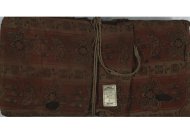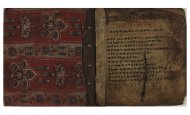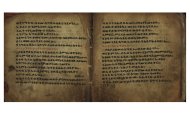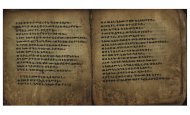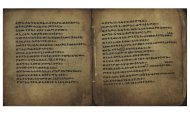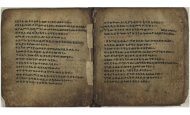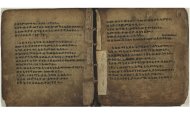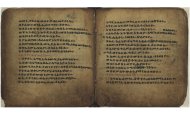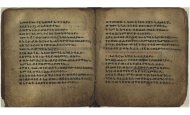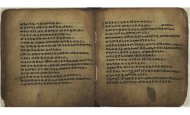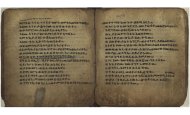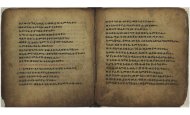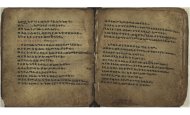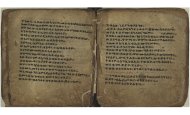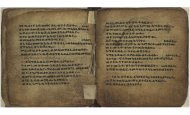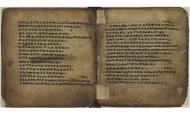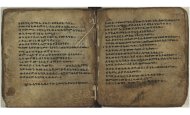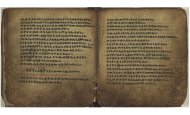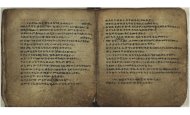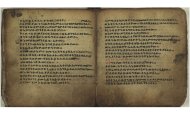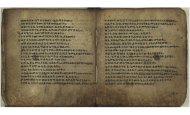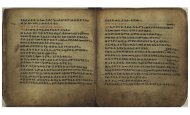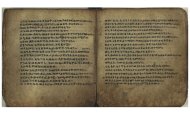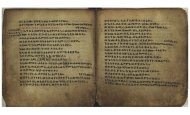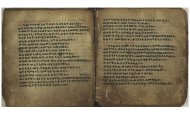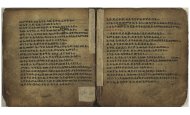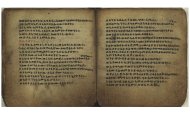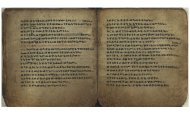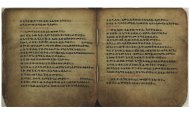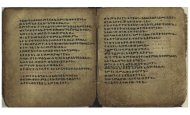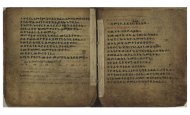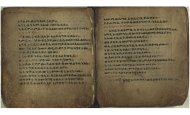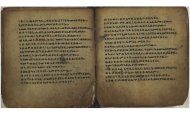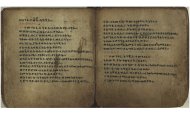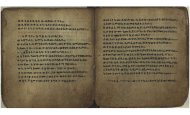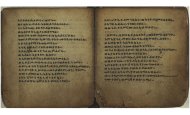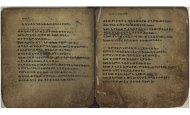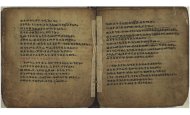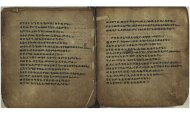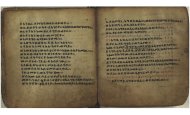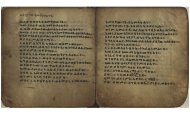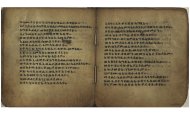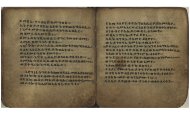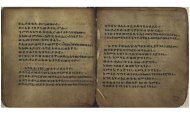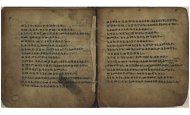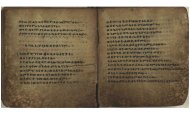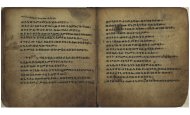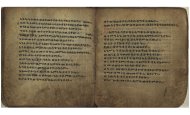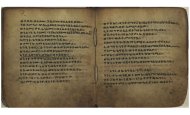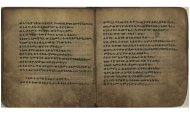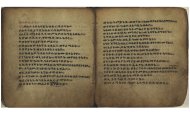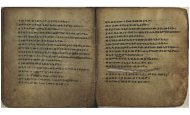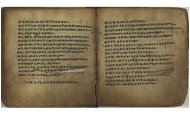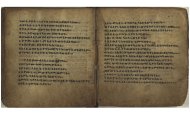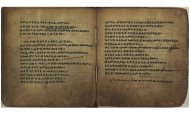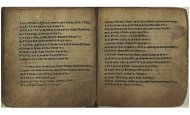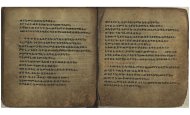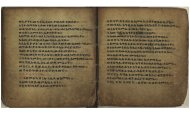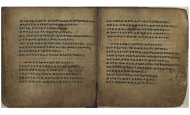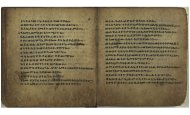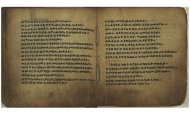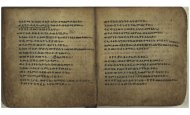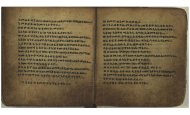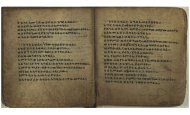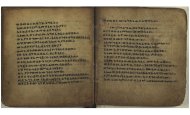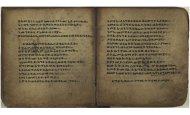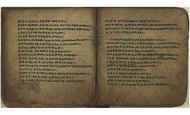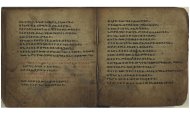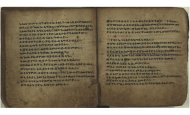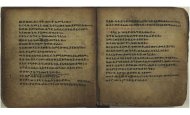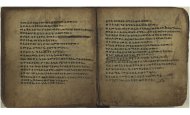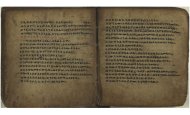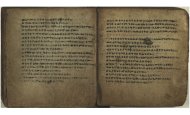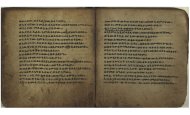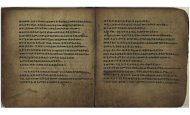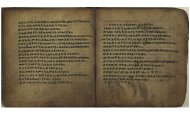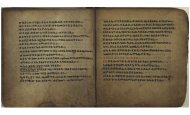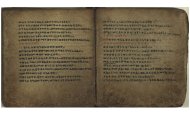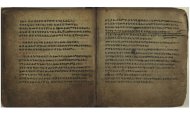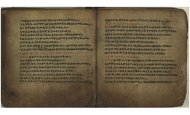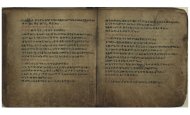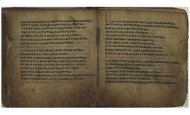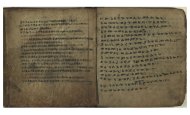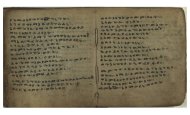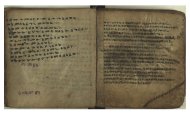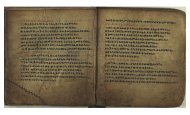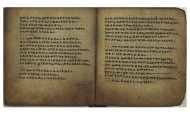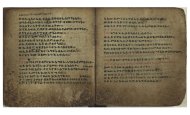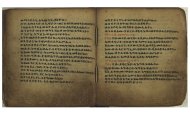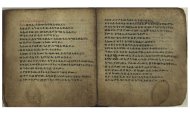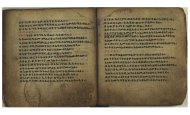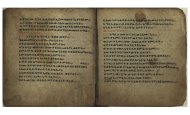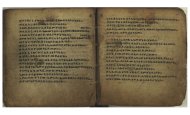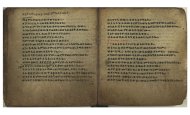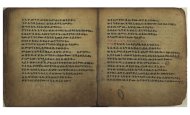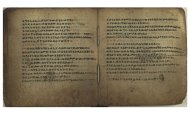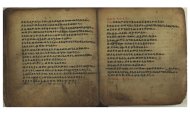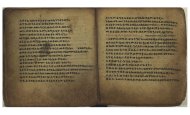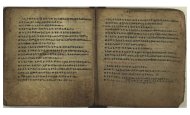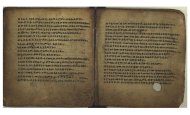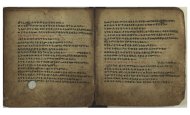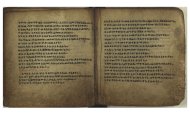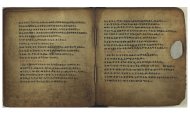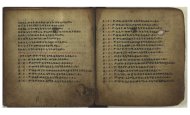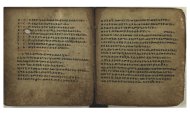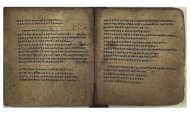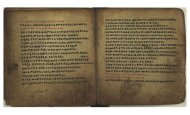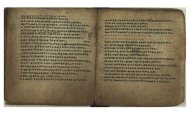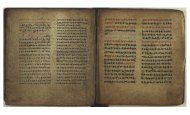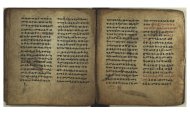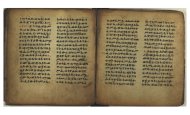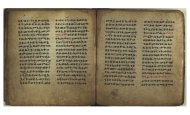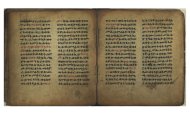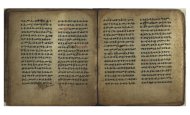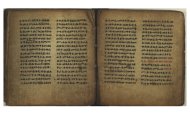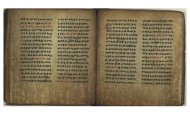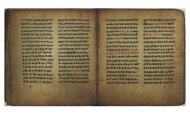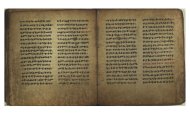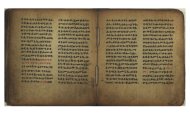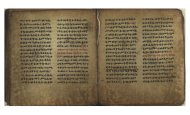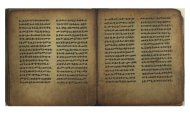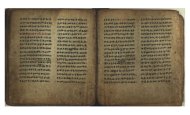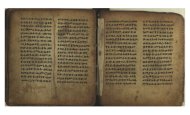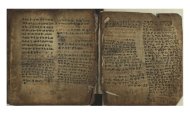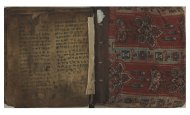|
Shelfmark |
Fondo Orientale, Crypt Aet. 6 |
|
Owning institution |
Biblioteca statale del Monumento nazionale di Grottaferrata |
|
Typology |
Codex The manuscript is composite. It consists of 2 codicological units: I (ff. 1–138), II (ff. 139–158) |
|
Copying date |
17th–18th century, dated on a paleographical basis. |
|
Title |
Dawit (Psalter) |
|
Subject |
Old Testament |
|
Language |
Gǝʿǝz |
|
Outer size (included the binding) |
186 x 170 x 77 mm |
|
Number of folia |
158 |
|
Binding |
Two wooden boards covered with decorated textile. Four sewing stations. |
|
Sewing |
Two Z-twisted threads (each is S-twisted) of vegetal origin. |
|
Sewing pattern |
Bozzacchi A4 |
|
Slip case (maḫdär) |
– |
|
Decoration |
– |
|
State of preservation of the binding |
Mediocre |
|
Provenance and history |
Unknown provenance. An ownership note on f. 138r states that at some time Unit I belonged to a certain Abba Gäbrä Mäsqäl, to his brother Kidanä Maryam and his father Wäldä Iyäsus (see below Unit I, Additional note 3) The manuscript was acquired by the abbey library between 1992 and 2000, since it is not mentioned by Osvaldo Raineri in Raineri O., 1991, ‘Rec. S. Uhlig, Introduction to Ethiopian Palaeography’. Orientalia Christiana Periodica, 58 (1991), 215–16, but it is catalogued by Delio Vania Proverbio in Proverbio D.V., 2000, ‘Inventario sommario dei manoscritti arabi, ebraici, etiopici – con notizia dei turchi – conservati presso la Biblioteca della Badia di Grottaferrata’. Atti della Accademia nazionale dei Lincei, Memorie, Classe di scienze morali, storiche e filologiche, serie IX, 12 (2000), 468–570. |
Unit I (ff. 1–138)
|
Folia |
Ff. 1–138 |
|
Copying date |
17th–18th century, dated on a paleographical basis. |
|
Short description of the content |
Ff. 1r–121v: Mäzmurä Dawit (“Psalms of David”); Ff. 122r–133r: Mäḥalǝyä näbiyat (“Canticles of the Prophets”); 1. Ff. 122r–123r: Ṣälotu läMuse (“Prayer of Moses”); 2. Ff. 123r–124r: [Ṣälot] zäMuse dagmay (“Second prayer of Moses”); 3. Ff. 124r–125v: [Ṣälot] zäMuse śalsay (“Third prayer of Moses”); 4. Ff. 125v–126r: Ṣälotä Ḥanna ǝmmä Samuʾel näbiyy (“Prayer of Hannah, mother of Samuel the prophet”); 5. F. 126r–v: Ṣälotä Ḥǝzqǝyas nǝguśä Yǝhuda (“Prayer of Hezekiah, king of Judah”); 6. Ff. 126v–127v: Ṣälotä Mǝnasse näbiyy (“Prayer of Manasseh the prophet”); 7. Ff. 127v–128r: Ṣälotä Yonas näbiyy (“Prayer of Jonah the prophet”); 8. Ff. 128r–129r: Ṣälotä Danǝʾel näbiyy (“Prayer of Daniel the prophet”); 9. F. 129r–v: Ṣälotä 3däqiq (“Prayer of the three children”); 10. Ff. 129v–130v: Ḫabä baräku Ananya wäʾAzarya wäMisaʾel (apocryphal prayer of Azariah); 11. Ff. 130v–131v: Ṣälotä ʿƎnbaqom näbiyy (“Prayer of Habakkuk the prophet”); 12. Ff. 131v–132v: Ṣälotä Isayǝyyas näbiyy (“Prayer of Isaiah the prophet”); 13. F. 132v: Ṣälotä Maryam (“Prayer of Mary”); 14. Ff. 132v–133r: Ṣälotä Zäkkaryas kahǝn (“Prayer of Zechariah the priest”); 15. F. 133r: Ṣälotä Sǝmʿon näbiyy (“Prayer of Simeon the prophet”). Ff. 133v–138r: Mäḥalǝyä mäḥalǝy (“Song of Songs”); F. 138va–b: Wǝddase Maryam (“Praise of Mary”). 1. F. 138va–b: Prayer for Monday. |
|
Writing material |
Sheep parchment |
|
Blank folia |
– |
|
Quires |
17 |
|
Quire marks |
– |
|
Layout |
1) Ff. 1–138r: 1 column. 2) F. 138v: 2 columns. |
|
Number of lines per column |
1) Ff. 1–138r: 17–18. 2) F. 138v: 22. |
|
Ruling |
Blind ruling, from inside to outside. Lines are written above the ruling (pattern Nosnitsin 1). |
|
Ruling pattern |
1-1-11/0/0/C. |
|
Scribe |
Unknown |
|
Colophon |
– |
|
Additional notes |
1. F. 40v: Ownership or purchase note, almost completely erased. Only the incipit is readable: ዝንቱ፡ መጽሐፍ፡. The following words are also readable on the next line: ዝንቱ፡ መጽሐፍ፡ ዘአጥረዮ፡. 2. Ff. 102r–103v: Ps 108:73–104 has been added in a recent hand on the central bifolium. Incipit: ዮድ፡ እደዊከ፡ ገብራኒ፡ ወለሐኳኒ። | አለብወኒ፡ ወእትመሀ ር፡ ትእዘዘከ። (sic) | እለ፡ ይፈርሁከ፡ ይርአዩኒ፡ ወትፌሥሑ። | እስመ፡ ተወከል ኩ፡ በነቢብከ። | አእመርኩ፡ እግዚኦ፡ ከመ፡ ጽድቅ፡ ኵሉ፡ ኵነኔከ።. 3. F. 138r: Ownership note written in a recent hand on the lower margin of the folio. The note states that the Psalter belonged to Abba Gäbrä Mäsqäl, to his brother Kidanä Maryam and his father Wäldä Iyäsus: ዝዳዊት፡ ዘአባ፡ ገብረ፡ መሰቀል፡ ዘጭ፡ ንቦርድ፡ አቦ። ወእሁሐ፡ ኪደነ፡ ማርያም፡ ወአቡሁ፡ ወልደ፡ ኢየሱስ፡ ይምሐሮሙ፡ ነፍሶሙ፡ ኵሎሙ፡ ምስለ፡ ዳዊት፡ ወለ፡ ጽሐ፡. |
|
Decoration |
Ff. 1r, 122r: ornamental frames (ḥaräg) on the top of the “Psalms of David” and the “Canticles of the Prophets”. The frames are executed in black and red ink and decorated with interweaving motifs. |
|
State of preservation of the textblock |
Mediocre |
|
Provenance and history |
See the general description. |
Unit I (ff. 139–158)
|
Folia |
Ff. 139–158 |
|
Copying date |
17th–18th century, dated on a paleographical basis. |
|
Short description of the content |
Ff. 139ra–152va: Wǝddase Maryam (“Praise of Mary”); 1. Ff. 139ra–140rb: Prayer for Monday; 2. Ff. 140rb–142rb: Prayer for Tuesday; 3. Ff. 142rb–144va: Prayer for Wednesday; 4. Ff. 144va–147rb: Prayer for Thursday; 5. Ff. 147rb–149ra: Prayer for Friday; 6. Ff. 149ra–150rb: Prayer for Saturday (qädamit sänbät); 7. Ff. 150rb–152va: Prayer for Sunday (sänbätä krǝstiyan). Ff. 152vb–157va: Anqäṣä bǝrhan (“Gate of Light”). |
|
Writing material |
Sheep parchment |
|
Blank folia |
– |
|
Quires |
3 |
|
Quire marks |
– |
|
Layout |
2 columns |
|
Number of lines per column |
18 |
|
Ruling |
Blind ruling, from inside to outside. Lines are written above the ruling (pattern Nosnitsin 1). |
|
Ruling pattern |
1-1-11/0/0/C. |
|
Scribe |
Unknown |
|
Colophon |
– |
|
Additional notes |
4. F. 157va: Condemnation against those who steal or erase the book. The note is written over erasure and the names of the individuals have been erased again: ዝመጽሐፍ፡ <…> ዘተሣየጦ፡ በንዋዮ፡ <…> ለመድኃኒተ፡ ነፍስ፡ ወሥጋ፡ ባሕ ቱ፡ ዘሰረቆ፡ ወዘፈሐቆ፡ ወተአገሎ፡ በአፈ፡ ጴጥሮስ፡ ወጳውሎስ፡ ውጉዘ፡ ወም ቱረ፡ ለይኩን፡ ለይኩን፡. 5. Ff. 157vb–158vb: Ǝsäggǝd läki ǝsäggǝd läki ǝsäggǝd läki wäʾǝweddǝsäki (“I worship you, I worship you, I worship you and I praise you”, Hymn to the Virgin Mary, Chaine nr. 338). The hymn is written in an inaccurate hand. The refrain of each stanza is rubricated. Incipit: [እ]ሰግድ፡ ለኪ፡ ወ[እ]ዌድስኪ፡ ኦእ ግዝእትየ፡ ቅድስት፡ ድንግል፡ ማርያም፡ ወላዲተ፡ አምላክ፡ በከመ፡ ወደሱኪ፡ ወሰገዱ፡ ለኪ፡ መላእክት፡. |
|
Decoration |
– |
|
State of preservation of the textblock |
Mediocre |
|
Provenance and history |
See the general description. |


